Partners Help Pest Management Interest Soar in N.H. in 2022

Warmer, dryer summers and changes in rainfall patterns in New Hampshire have caused pest management challenges for fruit and vegetable producers in the Granite State. NRCS has responded with a partner approach and demonstrations to help producers understand programs that support their operations.
The New Hampshire agricultural sector has seen its challenges in the last few years. Intense periods of rainfall followed by prolonged periods of abnormally dry weather in the state has brought emerging challenges that make operations for producers anything but status quo. The U.S. Dept. of Agriculture’s, Natural Resources Conservation Service (USDA-NRCS) in New Hampshire continues to leverage partnerships and science-based methods to assist these producers through voluntary conservation practices.
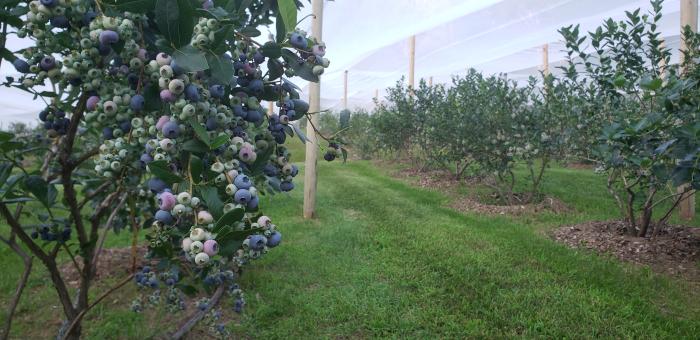
The weather patterns in recent years have resulted in many producers noticing an uptick in species of destructive insects that are not normally seen in the region. Species such as spotted-winged drosophila are becoming more prevalent. Managing these pests in a sustainable way has become an important part of the NRCS’s support to our local producers. In fiscal year 2022, NRCS in New Hampshire worked with producers in voluntary conservation practices to meet the local demand to effectively manage these pests.
This year we made a concentrated effort to assist orchards and other vegetable growers with Integrated Pest Management (IPM) activities throughout the Merrimack River Valley and beyond, explains New Hampshire NRCS State Conservationist Becky Ross. “This was a great example of the locally led conservation process at work,” said Ross. “Our local work groups expressed the need and we responded with scientifically proven technical guidance and successful implementation of voluntary practices to support the work group's vision.”
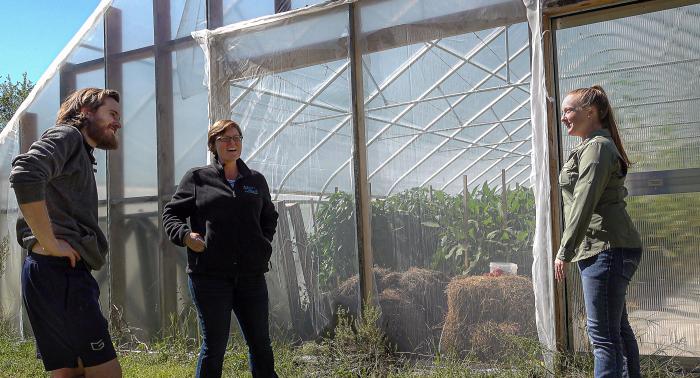
Through the NRCS partnership with the Xerces Society for Invertebrate Conservation, NRCS in New Hampshire was able to hire a Partner Biologist position in 2020. That biologist, Alina Cypher, Integrated Pest and Pollinator Management Specialist, helped provide the scientific background that buttressed the agency’s ability to answer the demands of local producers trying to feed a growing state.
“This effort was to support the market shift of buyers and growers who demand to see fewer, or more precise, pesticide applications on consumable foods,” said Ross. “Our NRCS Soil Conservationists, are uniquely positioned to reach all of our customers every day to ensure that producers have access to these programs that can help them meet their goals.”
Along with multiple NRCS field staff, the University of New Hampshire Extension Field Specialist, Jeremy DeLisle and Rockingham, Strafford, and Cheshire County Conservation Districts continue to work through a Conservation Innovation Grant (CIG) to establish demonstration projects that help spread the benefits of IPM practices. The results have generated significant interest from producers; applications for the Environmental Quality Incentive Program (EQIP) to support these practices is rising.
This past year we have experienced an increased interest in IPM practices within the valley, explains Jessica Rock, District Conservationist for Merrimack, and Hillsborough Counties. “Staff in multiple offices connected with several of our local producers resulting in more than a dozen applications to participate in our programs. This translates to more than $500k in requested financial assistance programs under EQIP – there is definitely a desire from our producers for this assistance.”
Interest in Integrated Pest Management practices have spanned across the state; last year NRCS funded projects covering nearly 1,200 acres of cropland in New Hampshire.
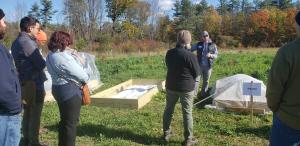
“Collaborating with the agricultural service providers and partner farms involved with this project has been extremely beneficial to all involved,” explains DeLisle. “It has allowed all of us to better understand the needs of the various stakeholders, bolstered communication between all parties, increased the understanding of programs available to support IPM initiatives, and facilitated the sharing of research-based best practices. This project is a prime example of how collaborative partnerships can result in amplified impacts for the betterment of our agricultural communities and the people they provide for.”
The initial focus of the CIG was on controlling these pest species in a way that mitigates or reduces pesticides and protects native beneficial insects like pollinators. This required producers to understand options that were available to them through NRCS technical and financial assistance programs including: use of insect exclusion netting in lieu of pesticides, pesticide sprayer calibration for increased application accuracy, and well-timed applications based on scouting, trapping, and weather models that will have the highest impact on the targeted pest species.
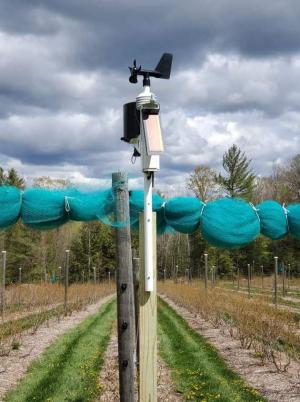
The team of partners made a large effort on engaging producers on the evolved science of pest management – where weather and timing are critical. Weather at the local level is a big factor that influences the timing of when pest species may impact crops. A late spring day in one part of the state may yield no pest activity for one producer, while another producer 20 miles away may experience a boom in pests due to a slightly different microclimate.
To support the knowledge of local producers on when to best apply pesticides to be most effective, and minimize excess applications, the team set out to increase the network of weather stations. Producers volunteered to host a weather station at their operation to collect local data on the microclimate. That data is made available online, increasing accessibility for all producers.
“The beauty of weather stations is that its benefit extends far beyond the farm where it is installed,” explains Cypher. “Other neighboring farms and research projects can make use of this data, both in real-time to make more accurate pest management decisions, as well as retrospectively to confirm hunches as to why a crop responded differently after certain weather patterns,” she said.
More than a dozen weather stations were installed under the innovation grant with many more being installed under EQIP financial assistance offered by NRCS.
Demonstrations with producers under the CIG also showcased the viability of insect exclusion netting that reduces the need for pesticides. Partner producers at Heron Pond Farm, Stark Farm, and Bascom Road Blueberry Farm volunteered to trial the exclusion netting and host field days for other local producers to see and hear about the practices. “Surveys indicate that growers love to learn from other growers, making these on-farm demonstrations and field days key to widespread adoption,” said Cypher. “Potential adopters hear directly from other farmers about their successes and challenges, while the discussion is fostered by agriculture and conservation specialists,” she said.
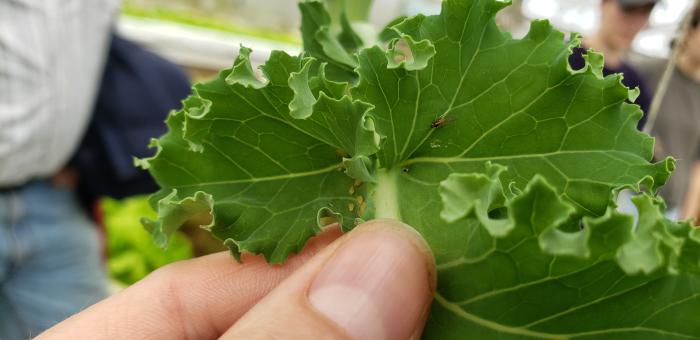
“The netted structures over blueberry blocks have been wildly successful for the growers that volunteered to adopt them,” explains Cypher. “It's been an educational opportunity for growers to explain the system to their pick-your-own customers.”
This level of buyer awareness has also translated to educating consumers about pesticides and produce explains Cypher. “Customers love picking beneath the structure, particularly since it symbolizes an alternative to pesticides. These netted structures also allow producers to extend their growing and picking season by about a month, which makes everybody happy – who doesn’t love fresh blueberries?”
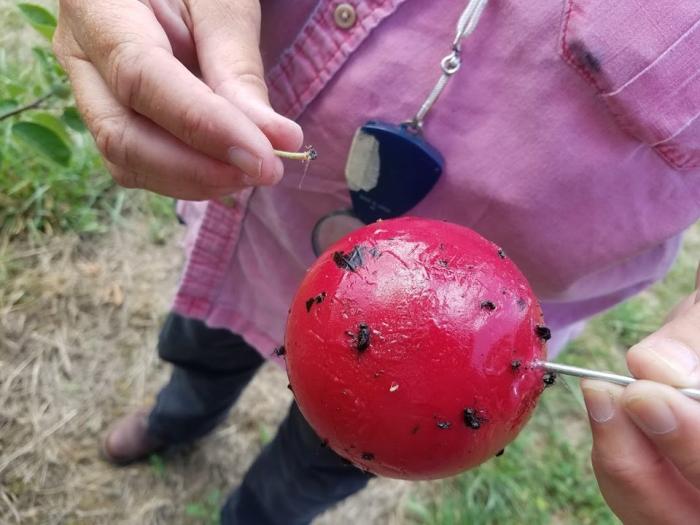
This year, the team is working to spread the merits of low-tunnel systems, an interim NRCS practice expected to be adopted by the agency. Cypher explains that low tunnels consist of knee-high hoops inserted into the soil that are covered with an array of materials, such as netting, plastic, or shade cloth. “These structures can be used to protect crops from sun, wind, excessive rainfall, cold, and to extend the growing season with overwintering crops. Like a smaller, lower-tech version of the blueberry netting, they can be used to exclude insect pests and in turn reduce pesticides,” she said.
Cypher is hopeful that the knowledge and compilation of the material and labor costs will help lay the groundwork for the NRCS to create a practice scenario to address the devastating non-native insects as a first line of defense before reaching for pesticides. “One of the blueberry producers was considering throwing in the towel on their operation,” recounts Cypher, “they went from crying sad tears, to being selected for this voluntary assistance and crying happy tears – stories like this are incredibly rewarding and inspire us all!"

Additional Information
If you are interested in how NRCS programs can help you on your operation, please contact your local USDA Service Center.
Local Service Centers - New Hampshire
New Hampshire NRCS operates from seven field offices in various USDA Local Service Centers across the state. State staff operates out of the State Office located in Dover New Hampshire.
Learn More

